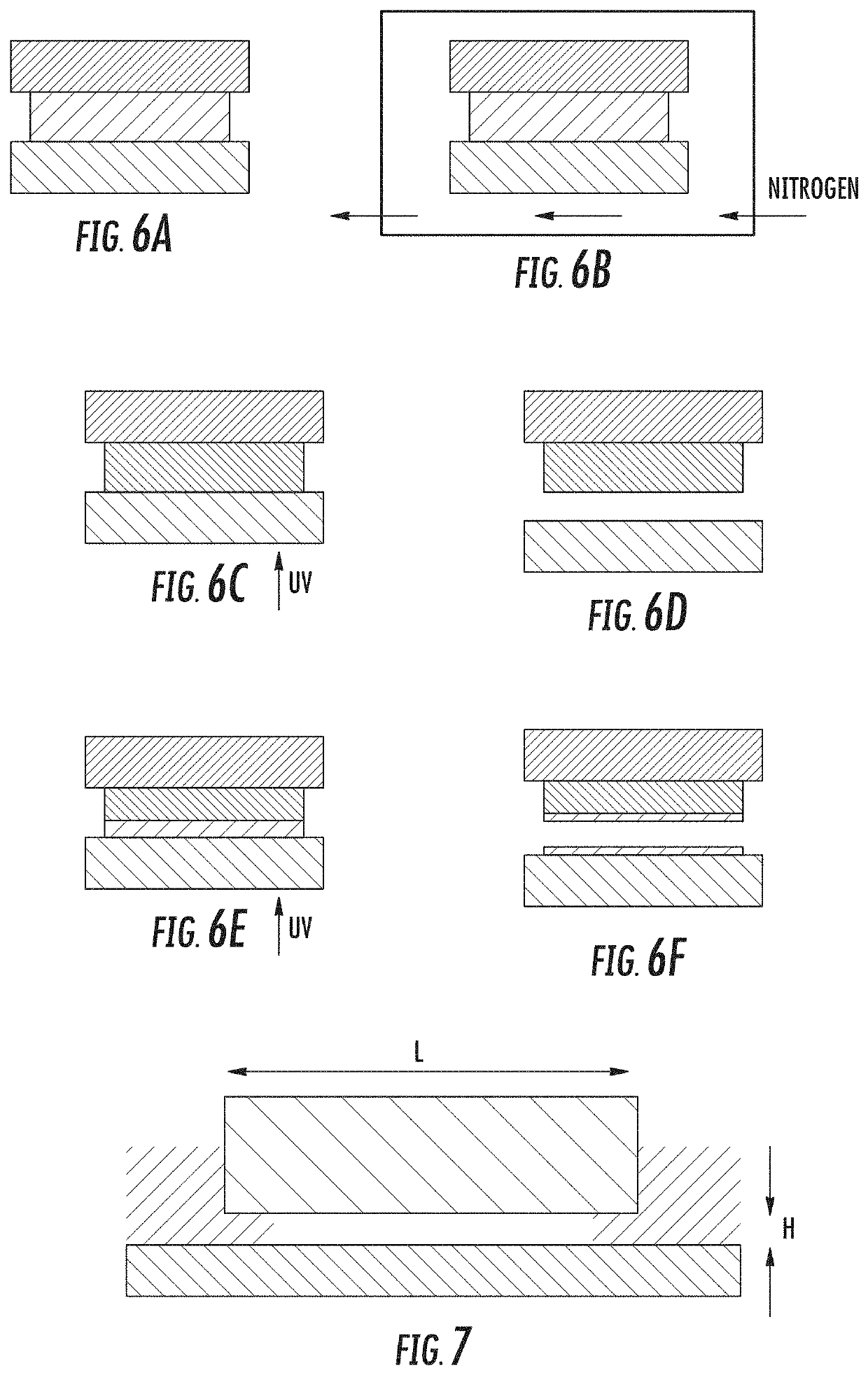Method and apparatus for three-dimensional fabrication
a three-dimensional object and fabrication method technology, applied in the direction of prosthesis, program control, instruments, etc., can solve the problems of needing to submerge, use additional mechanical elements, extreme care, etc., to facilitate the re-filling of polymerizable liquid, enhance the photopolymerization cure chemistry, and reduce the viscosity of the liquid
- Summary
- Abstract
- Description
- Claims
- Application Information
AI Technical Summary
Benefits of technology
Problems solved by technology
Method used
Image
Examples
example 1
Inhibitor Transfer to Build Surface from a Separate Feed Surface
[0150]A drop of ultraviolet (UV) curable adhesive was placed on a metal plate and covered with 10 mm thick plate of TEFLON® AF fluoropolymer (a amorphous, glassy polymer) as shown in FIG. 5a. UV radiation was supplied to the adhesive from the side of Teflon AF as shown in FIG. 5b. After UV exposure the two plates were separated. It was found that no force was required to separate the two plates. Upon examination of the samples it was discovered that the adhesive was cured only next to the metal plate, and that a thin film of uncured adhesive was present on the Teflon AF fluoropolymer plate and also on the cured portion of the adhesive as shown in FIG. 5c.
[0151]Two controlled experiments were also performed where clean glass (FIGS. 5d-5f) and also glass treated with release layer (FIGS. 5g-5i) was used. It was confirmed that considerable force was needed to separate clean glass from the metal and it was found that adhes...
example 2
Inhibitor Transfer Through Build Plate to Build Surface
[0153]Samples 1 and 2 were prepared in a similar manner wherein a drop of UV curable adhesive was placed on a metal plate and covered with 10 mm thick plate of TEFLON® AF fluoropolymer as shown in FIG. 6a. Both samples were exposed to a nitrogen environment to eliminate any presence of oxygen as shown in FIG. 6b. Next both samples were brought into a standard atmosphere environment and Sample 1 was immediately exposed to UV radiation while Sample 2 was exposed to UV radiation 10 minutes after being in the atmosphere environment. Both samples were exposed to the same amount of UV radiation as shown in FIG. 6C and FIG. 6E. Upon examination of the samples after UV exposure it was discovered that the adhesive was cured completely in Sample 1 as shown in FIG. 6D and only next to the metal plate in Sample 2 as shown in FIG. 6F. A thin film of uncured adhesive was present on the Teflon AF fluoropolymer plate and also on the cured porti...
example 3
Increasing Fabrication Rate: Pressure
[0154]A highly oxygen permeable, and UV transparent material is used as the bottom of a chamber filled with photocurable resin in a device of the invention. During construction, the top of an object is attached to a support plate which is moved up at a substantially constant speed while the bottom portion of the object is constantly being formed just above the bottom of the chamber. The gap between the bottom of the object and the bottom of the chamber is always filled with resin. As the object is being formed and advanced, the resin in the gap is constantly replenished with supply resin contained in the chamber.
[0155]The speed of the object's formation depends on the viscosity of the resin η atmospheric pressure P, the height of the gap between the object and the bottom of the chamber h, and the linear dimension L of the object's bottom surface. Simple calculations are performed to estimate this speed using the theory of viscous flow between two...
PUM
| Property | Measurement | Unit |
|---|---|---|
| time | aaaaa | aaaaa |
| time | aaaaa | aaaaa |
| time | aaaaa | aaaaa |
Abstract
Description
Claims
Application Information
 Login to View More
Login to View More - R&D
- Intellectual Property
- Life Sciences
- Materials
- Tech Scout
- Unparalleled Data Quality
- Higher Quality Content
- 60% Fewer Hallucinations
Browse by: Latest US Patents, China's latest patents, Technical Efficacy Thesaurus, Application Domain, Technology Topic, Popular Technical Reports.
© 2025 PatSnap. All rights reserved.Legal|Privacy policy|Modern Slavery Act Transparency Statement|Sitemap|About US| Contact US: help@patsnap.com



